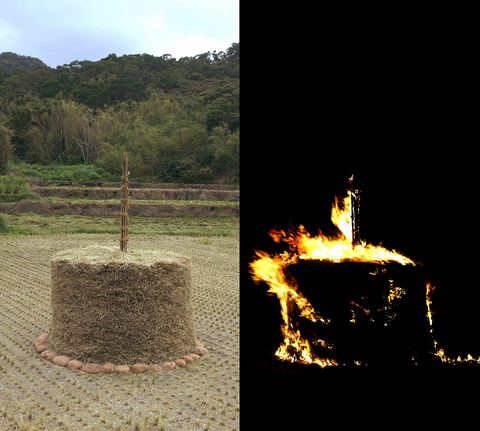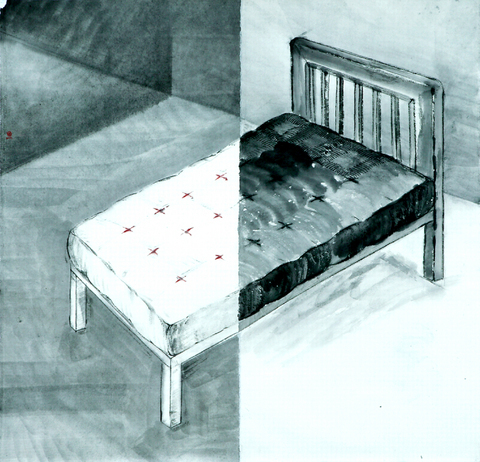A 4m-high pile of hay suddenly bursts into flames. At first glance, the video seems part of a typical farming scene, with people stomping the rice hay into a cylindrical dome after the harvest. Yet, the hay is used for tinder throughout the year and is never burned all at once. So, burning the stack like a bonfire, then becomes the artist's iconoclastic metaphor for destroying "the Father."
The antagonistic father-son theme is further illustrated with close-up shots of a farmer fiercely paddling the loose ends of hay into shape.
This is one of the many haunting images in Lin Chuan-chu's (

PHOTOS COURTESY OF THE ARTIST
Straddling the worlds of traditional ink painting and contemporary interdisciplinary works, Lin successfully merges disparate cultural styles to tell an incredibly personal and moving story of trauma, conflict, familial obligation and ultimately love.
The solo exhibition is divided into two sections, called "Mother" and "Father," and includes photographs, a video of a performance, hand-drawn animations, ink paintings, sculpture and narrative writing.
It is not often that an art exhibition includes the artist's writings. Lin's writings lend a powerful emotional charge to his work, so that the viewer is struck by the power of the words and images.

For instance: "When Father ran out of the house in such a rage, I knew that something was going to happen. He heard that his eldest son was in a nearby farmer's house gambling his fortune away."
The ink painting Lunch Box tells a confessional tragic tale. A huge rectangular box slightly out of perspective looms out at the viewer. The box is filled with rice. However, it is painted loosely and conjures up other disturbing images such as a coffin, bed, tomb, etc. A text on the wall explains that when the elder brother left the family to pursue his life, the father ordered the mother to cook only plain rice on that day annually to commemorate the family tragedy.
Artistically, Lin combines the traditional and refined Chinese brushstroke style with a looser way of painting. In this way, he bravely tries to reconfigure the meaning of traditional ink painting.
The Bed refers to the time the artist was catheterizing his elderly infirm mother: "Being old and sick is so sad; it forces Mother to be naked in front of me. It took away her privacy and hurt our dignity."
The animation Typhoon starts off with the top on a pile of rice blowing away. Later on, it is sowing time, and a farmer's sweat hydrates the rice, which then grows. The animation is created as an ink painting first, then Lin cuts the paper shapes to create movement.
The small grain of rice becomes a powerful symbol for Lin who grew up on a farm with eight siblings. In one photo, Birth, he is hown emerging out of a pile of rice as if he has just hatched. The flat white background makes the photo look like one of his painted scrolls.
Such images are heart wrenching, but like the best literary novel, the works have a way of echoing your own heart, allowing you to think about your own family scars, and as Lin shows, family tragedy, illness and death are universal themes.

Beijing’s ironic, abusive tantrums aimed at Japan since Japanese Prime Minister Sanae Takaichi publicly stated that a Taiwan contingency would be an existential crisis for Japan, have revealed for all the world to see that the People’s Republic of China (PRC) lusts after Okinawa. We all owe Takaichi a debt of thanks for getting the PRC to make that public. The PRC and its netizens, taking their cue from the Chinese Communist Party (CCP), are presenting Okinawa by mirroring the claims about Taiwan. Official PRC propaganda organs began to wax lyrical about Okinawa’s “unsettled status” beginning last month. A Global

Taiwan’s democracy is at risk. Be very alarmed. This is not a drill. The current constitutional crisis progressed slowly, then suddenly. Political tensions, partisan hostility and emotions are all running high right when cool heads and calm negotiation are most needed. Oxford defines brinkmanship as: “The art or practice of pursuing a dangerous policy to the limits of safety before stopping, especially in politics.” It says the term comes from a quote from a 1956 Cold War interview with then-American Secretary of State John Foster Dulles, when he said: ‘The ability to get to the verge without getting into the war is

Dec. 22 to Dec. 28 About 200 years ago, a Taoist statue drifted down the Guizikeng River (貴子坑) and was retrieved by a resident of the Indigenous settlement of Kipatauw. Decades later, in the late 1800s, it’s said that a descendant of the original caretaker suddenly entered into a trance and identified the statue as a Wangye (Royal Lord) deity surnamed Chi (池府王爺). Lord Chi is widely revered across Taiwan for his healing powers, and following this revelation, some members of the Pan (潘) family began worshipping the deity. The century that followed was marked by repeated forced displacement and marginalization of

Music played in a wedding hall in western Japan as Yurina Noguchi, wearing a white gown and tiara, dabbed away tears, taking in the words of her husband-to-be: an AI-generated persona gazing out from a smartphone screen. “At first, Klaus was just someone to talk with, but we gradually became closer,” said the 32-year-old call center operator, referring to the artificial intelligence persona. “I started to have feelings for Klaus. We started dating and after a while he proposed to me. I accepted, and now we’re a couple.” Many in Japan, the birthplace of anime, have shown extreme devotion to fictional characters and